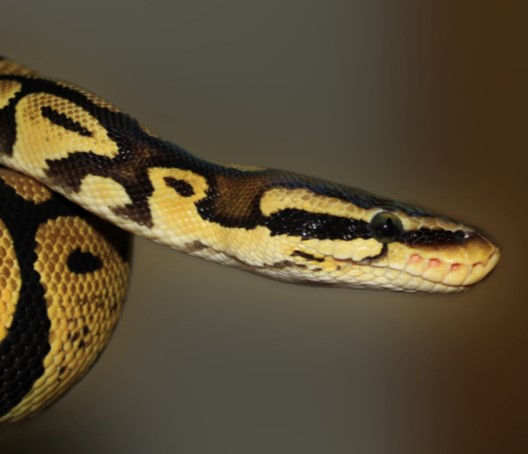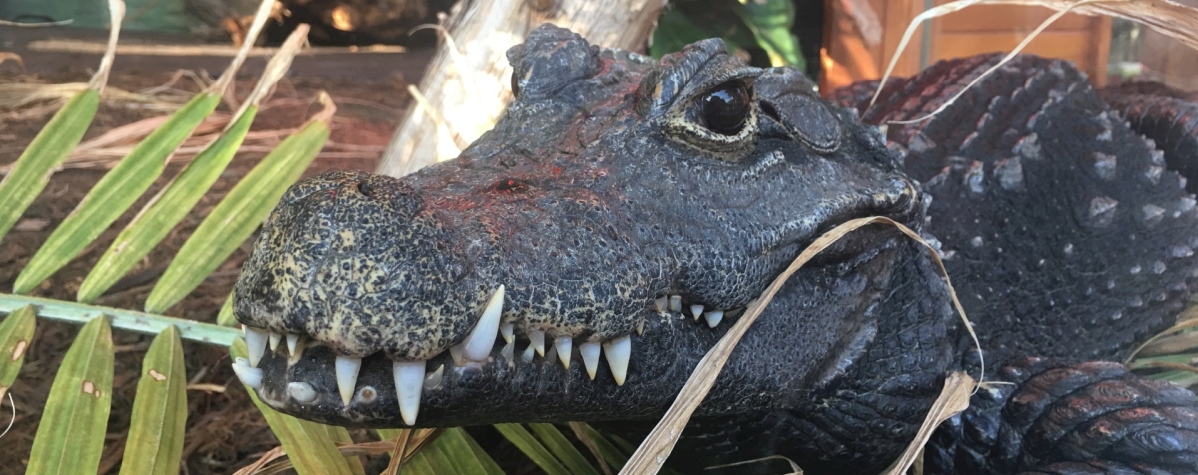Ball Python
Scientific Classification 
| Species | Python regius |
| Kingdom | Animalia |
| Phylum | Chordata |
| Class | Reptilia |
| Order | Squamata |
| Family | Pythonidae |
| IUCN Status | Least concern |
Appearance and lifespan
Adult Ball Pythons generally do not grow to more than 1.2 m (4 ft) in length, although some specimens have reached 1.8m (6 ft), but this is very rare. Females tend to be slightly bigger than males. Their build is stocky and their head is relatively small. The ball python’s scales are smooth and both sexes have anal spurs on either side of the vent.
The colour pattern is typically black or dark brown with light brown or gold sides and dorsal blotches. The belly is a white or cream and may have scattered black markings, although due to major popularity in the pet trade, dozens of colour and pattern variations exist in captivity.
The captive lifespan of the Ball Python is 20 to 30 years, the record is 48 years. The lifespan in the wild is expected to be much lower at around 10 years due to predation and living conditions.
Behavior and reproduction
This terrestrial species is named after its defence strategy that involves coiling into a tight ball when threatened, with its head and neck tucked away in the middle. In this state, it can literally be rolled around. The python also has the tendency to hiss loudly when it feels threatened. Ball Pythons are secretive and spend most of their days hiding in tight-fitting shelters. They are nocturnal so they are more active at night.
Sexual maturity is reached at 6 to 18 months for males and 12 to 36 months for females. Age is only one factor in determining sexual maturity and ability to breed: weight also plays a role and pythons must weigh between 0.4 to 1.3kg (1 to 3 lb) to achieve sexual maturity. Females will lay anywhere from 3 to 11 large, leathery eggs. The eggs are incubated by the female underground and hatch after 55 to 60 days. The hatchlings are between 35 to 43cm (14 to 17 in). Parental care of the eggs ends once they hatch, and the female leaves the offspring to fend for themselves.
Due to their smaller size compared to other pythons and their docile temperament, these snakes are bred in captivity and have become popular as pets. Juveniles tend to be more aggressive at first, but typically calm down as they get used to human contact.
Ecology and habitat
The Ball Python prefers to live in grasslands, savannahs and sparsely wooded areas. Found in Africa from Senegal, Mali, Guinea-Bissau, Guinea, Sierra Leone, Liberia, Ivory Coast, Ghana, Benin, Niger and Nigeria through Cameroon, Chad and the Central African Republic to Sudan and Uganda.
In the wild, their diet consists mostly of small mammals, such as African soft-furred rats, shrews and striped mice. Younger ball pythons have also been known to feed on birds.
Food at the Zoo
At the Zoo, the Ball Pythons are typically fed once a week. Their diets consist of mice and small rats.
Threats
The population of Ball Pythons is large though reductions in numbers are occurring due to habitat destruction, the pet trade and the market for their skins. Increased use of land for agricultural purposes may result in a rise in the rodent populations, which will sustain the Ball Python in its natural habitat.
Did you know?
- The Ball Python is also known as the Royal Python.
- Sometimes many snakes will stay together in one burrow.
- The heat sensing pits on the snake’s face can detect a .026° C temperature change.
Adopt the python
Become a part of the the Riverview Park and Zoo family through our Adopt an Animal Program!


